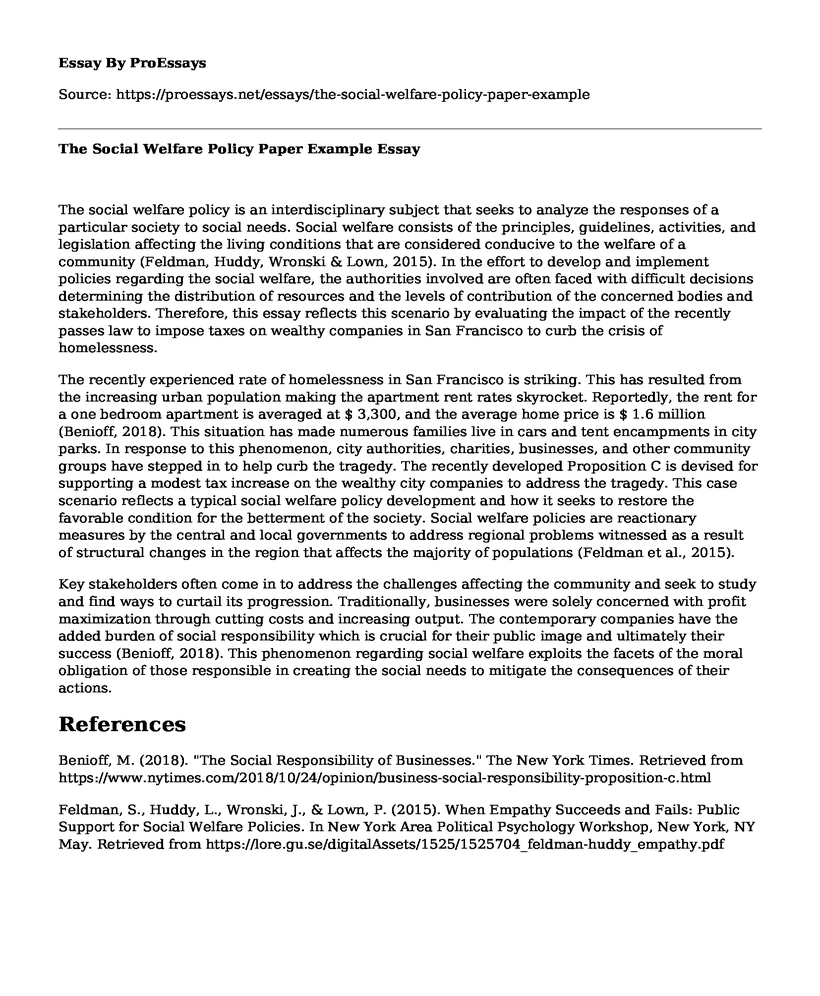The social welfare policy is an interdisciplinary subject that seeks to analyze the responses of a particular society to social needs. Social welfare consists of the principles, guidelines, activities, and legislation affecting the living conditions that are considered conducive to the welfare of a community (Feldman, Huddy, Wronski & Lown, 2015). In the effort to develop and implement policies regarding the social welfare, the authorities involved are often faced with difficult decisions determining the distribution of resources and the levels of contribution of the concerned bodies and stakeholders. Therefore, this essay reflects this scenario by evaluating the impact of the recently passes law to impose taxes on wealthy companies in San Francisco to curb the crisis of homelessness.
The recently experienced rate of homelessness in San Francisco is striking. This has resulted from the increasing urban population making the apartment rent rates skyrocket. Reportedly, the rent for a one bedroom apartment is averaged at $ 3,300, and the average home price is $ 1.6 million (Benioff, 2018). This situation has made numerous families live in cars and tent encampments in city parks. In response to this phenomenon, city authorities, charities, businesses, and other community groups have stepped in to help curb the tragedy. The recently developed Proposition C is devised for supporting a modest tax increase on the wealthy city companies to address the tragedy. This case scenario reflects a typical social welfare policy development and how it seeks to restore the favorable condition for the betterment of the society. Social welfare policies are reactionary measures by the central and local governments to address regional problems witnessed as a result of structural changes in the region that affects the majority of populations (Feldman et al., 2015).
Key stakeholders often come in to address the challenges affecting the community and seek to study and find ways to curtail its progression. Traditionally, businesses were solely concerned with profit maximization through cutting costs and increasing output. The contemporary companies have the added burden of social responsibility which is crucial for their public image and ultimately their success (Benioff, 2018). This phenomenon regarding social welfare exploits the facets of the moral obligation of those responsible in creating the social needs to mitigate the consequences of their actions.
References
Benioff, M. (2018). "The Social Responsibility of Businesses." The New York Times. Retrieved from https://www.nytimes.com/2018/10/24/opinion/business-social-responsibility-proposition-c.html
Feldman, S., Huddy, L., Wronski, J., & Lown, P. (2015). When Empathy Succeeds and Fails: Public Support for Social Welfare Policies. In New York Area Political Psychology Workshop, New York, NY May. Retrieved from https://lore.gu.se/digitalAssets/1525/1525704_feldman-huddy_empathy.pdf
Cite this page
The Social Welfare Policy Paper Example. (2022, Sep 21). Retrieved from https://proessays.net/essays/the-social-welfare-policy-paper-example
If you are the original author of this essay and no longer wish to have it published on the ProEssays website, please click below to request its removal:
- Employee Motivation in Fortune 500 Companies Paper Example
- The Fiscal and Monetary Policy Essay Example
- Pat Brown: Father of Modern California Essay Example
- Nursing Beliefs and Practices Essay Example
- Essay Example on Atterberg Limits: Shrinkage, Plastic & Liquid Limits
- Comparative Essay on Constitution and Articles of Confederation
- Essay Example on Apple's Leadership Edge: How Steve Jobs Transformed Performance







